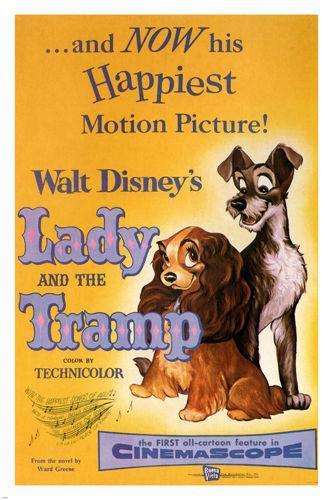
Disney. No one name holds as much power over business and the world of Animation as much as Walter Elias Disney. Whether it was making the first animated motion picture in the English world, further revolutionizing the field of animation, or making one of the most powerful media companies in the world, Disney managed to become a titan of industry and media. Nowadays, we joke about the House of Mouse and its’ lasting impact in today’s world…but without Disney, much of the animated world today…well…wouldn’t be.
The Lady and the Tramp: A Nostalgic set of Firsts

Following Peter Pan, Disney decided to do a bunch of firsts for his next movie. First, they changed distributors from RKO to Buena Vista. Second, this one would take place in the 1890s, much closer to when the movie was released (1955, for those curious), and definitely a favorite time for Walt. It was his childhood, after all, and he based the movie in his hometown of Marceline, Missouri. Third, the movie would have a heroine instead of a hero…groundbreaking for the 1950s. It was, mostly, based on a contemporary story…except for one part, which was based on an event in Walt’s life.
The Plot: One Christmas day, Jim Dear (Yes, that’s his name here) gives his wife, Darling (Again, yes that’s her name here), a gift in a hat box. She is surprised to receive an adorable Cocker Spaniel puppy that she immediately names “Lady”.
After a few…bumps regarding training the puppy, time speeds up and we cut to Lady as a beautiful adult, loved by her owners and doing dog things…like digging up the flowers (and trying to put them back), chasing rats and pigeons…and the occasional mailman. She finally gets her collar and license, and shows it to her neighbors, Scottish Terrier Jock, and Southern bloodhound Trusty. Meanwhile, our “Tramp” (mind you, this was a different use of the word then, the foreign dubs usually titled this film “Lady and the Vagabond”) is enjoying his life on the streets and being gifted bones from a local restaurant.
After this, Lady begins to notice a few changes in her home. Her loving owners have become a bit more strict. Jim dear actually hits her once! (Nowadays, we know better than to use corporate punishment on kids and dogs, but back then it was acceptable. Now it just makes animals scared of us or just genuinely confused as to what they did wrong). Trusty and Jock try to reassure her that it’s nothing that bad…an illusion that Tramp bursts out of “experience”. Her owners are having a baby, and she’s likely to be thrown out. Jock…is not amused and sends him off out of indignation.
The months come and go, and the baby is eventually born…and Lady finds she wants to protect him just as much as she wants to protect her owners. All well and good…except her owners go away for a bit and leave Aunt Sarah to look after the baby. Aunt Sarah also brought along her two Siamese cats who embody some of the most cringeworthy aspects of stereotypes for Asian people at the time (Check many of the Yellow Peril lists and you’ll find they fill most of the boxes. Ugh. On top of that, they behave nothing like real life Siamese cats, who are amongst the friendliest breeds out there…if not a bit LOUD). After a scuffle that Aunt Sarah believes Lady caused, she tries to Muzzle Lady…and Lady escapes.
Lady is saved by Tramp from three extremely aggressive dogs in a very realistic dog fight, and Tramp offers to get the muzzle off. A gopher gets it off at the nearby zoo, and Lady and Tramp go on a date where we get the iconic scene of both of them sharing the spaghetti kiss while being serenaded by the Italian chefs (Yes, stereotypical. We usually give this one a pass because they ship Lady and the Tramp together and are among the friendlier ones). After an incident where Lady accidently gets sent to the Pound, Lady’s rosy outlook on Tramp is shattered when the Pound dogs reveal that Tramp has a big weakness for females and she’s the latest one he’s loved.
Lady is eventually returned home and chained outside where her neighbors try to comfort her. Tramp reappears…and Lady tells him off in no uncertain terms. Meanwhile, the rat from earlier appears and makes it to where the baby is. Tramp gets called in and subdues the Rodent…and is mistaken for hurting the baby. Jim Dear and Darling tell off Aunt Sarah for mistreating their dog as Lady reveals the Rat and Jock and Trusty track down the dogcatcher to stop him from putting Tramp down. After a tense chase, we cut forward a few months to Christmas. Tramp is now adopted, there are now many puppies…and Trusty is healing from a broken leg.
The first scene of this movie was inspired by Walt giving his wife a puppy in a hatbox because he felt guilty for leaving her alone while doing his work. And she reacted just as much to her new puppy as Darling did to Lady. In fact, this movie actually made Cocker Spaniels a popular breed. It’s also, somewhat, blamed for much of the bad breeding that has caused some health and behavioral problems with the breed.
This is also the first Disney movie to be shot in Cinemascope, a pretty groundbreaking aspect ratio that has since continued to be used.
The story was actually going to be different, believe it or not, with another rival for Lady’s affections competing with Tramp’s. It was scrapped, but the character remains as one of the Pound dogs (the big Russian one). On top of that, the rat was originally going to be less of a menace, and more of a low grade trouble maker who spoke. He even had a name, Herman. The Cats were also supposed to react with shock at finding the rat, and believe it or not…Trusty would have died. Walt decided not to do that last one out of remembering the last time he killed a side character (After all, nobody forgot Bambi’s mother’s death).
Anyone who’s seen this movie and played video games might remember Ripper Roo from Crash Bandicoot’s laugh being similar to the hyena from this movie. They are the same sound effect, after all.



